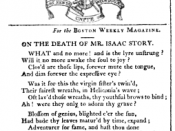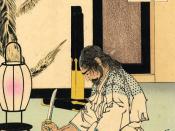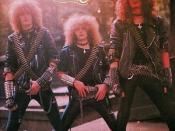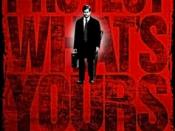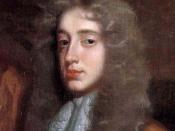Paper Assignment #1 Within lyric 1445, the author conveys an interesting view of death. The following essay will provide an interpretive analysis of this lyric. Through the use of symbolism, metaphors, association amongst key words, and rhythm, the author signifies the passage of death.
The main theme of this poem is the journey through life and eventually death. In the first two sentences, the author equates the journey of death to that of a dating relationship. The "supple Suitor" in the first sentence shows that death is at one's door gradually courting the person. The next two sentences, "It is a stealthy Wooing/ Conducted first" personifies a person who is eventually being "wooed" into "dating" death. In lines five and six in which the author writes, "By pallid innuendoes/ And dim approach," the author shows that the person in the poem does not yet have a clear vision of what death exactly is or that it is coming.
But, as the author will later show, the person progressively begins to clearly see death and his eventual destiny. In lines seven through ten, the author discusses the preparation and journey of death. The author writes, But brave at last with Bugles And a bisected Coach It bears away in Triumph To Troth unknown The fact that the author uses the word "Bugles" shows that the person is hearing the call of death. Also, the fact that the author uses the word "Coach" shows that the person is being carried away and preparing for the after life. In the next two sentences, the author begins to show that although the person dying is not sure of where his eventual resting place will be, he is quite sure of the fact that death has come to take him away. The author concludes in lines eleven and twelve by showing that the person has finally reached his destination in his journey to an environment, which is almost family like and as pure as "Porcelain." In this final context the word "Porcelain" can be equated to heaven.
The author uses many metaphors to symbolize death. The author begins his symbolism of death by calling it a "supple suitor," thereby giving it the characteristics of someone you love. Here, the author personifies death by giving it human characteristics. By using the word "supple," the author is trying to portray death as one who will forgive even if you have lived a life of sin. In the second line, the author uses the word "wins," which may symbolize the fact that death always wins. Death can overcome everything, and by doing so can creep in and out anytime it feels like. In the third and fourth lines, the author uses the words "stealthy Wooing" which means that death is good at its job and is slowly creeping in through the "door." This signifies that death is luring the person in question as one woos a woman or man he/she is interested in. In lines five and six, the author is painting a very faint picture. By using the words "pallid" and "dim," the author is creating a sense of darkness in describing death. Moreover, the author does not use the word "triumph" in the ninth sentence in its true meaning. Instead, I believe the author means to use it as form of conquest. For death to triumph does not only mean to win, because when death wins he takes all as a sort of conquest. The last word in the entire poem is the most important. "Porcelain" here may have a reference to heaven. Porcelain is pure and clean; therefore, as a familiar and wholesome place, the author intends to relate it to heaven. Also, one notices that certain words are capitalized. Within this poem, the capitalized words either stand for death or are a characteristic of it. For example the word "Suitor" represents death. It is death that does the "Wooing." It is also death that you hear through the "Bugles." Also, in lines three and nine, the word "It" refers to death.
Within this poem, there are significant associations among key words. For example, in line seven, the words "brave" and "bugle" can be considered to be associated with one another. Earlier in this paper I mentioned the fact that the word "bugle" stands for the call of death. In this case, the use of these two words convey the fact that the person hears the call of death and is brave enough to face it. Also, in lines two, eight, and nine, the words "wins," "coach," and "triumph" are associated with one another. A coach is one who guides his team to "triumph" over another, to "win" over their opponents. As mentioned above, the author uses the words "pallid" and "dim" to create a sense of darkness. These two words are also associated with one another. Pallid and dim both mean pale, colorless, white, and bland. Both of these words are describing characteristics of death as being lifeless.
In this poem, there are instances where the author uses alliteration. For example, in the first line of the poem, the author uses the words "supple suitor." Also, in the seventh line, the author says, " But brave at last with Bugles." But, brave, and bugles are also examples of the use of alliteration. The author also uses assonance with the use of the words "approach" and "coach." The words "suitor" and "wooing" also display the use of assonance.
There is no clear rhyme pattern in the poem. However, there is indication of the presence of end rhyme, such as in lines six and eight. The poem appears to have been written in trochaic meter; however, some of the lines are of uneven feet. For example, "But brave at last with Bugles and a bisected Coach" has thirteen syllables, whereas most of the other lines contain eleven.
The writer uses a variety of poetic conventions - symbolism, metaphors, alliteration and rhythm - to convey her ideas about death.

